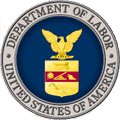United States Department of Labor
|
|

| |
| Established: | March 4, 1913 |
| Activated: | March 5, 1913 |
| Secretary: | Elaine L. Chao |
| Deputy Secretary: | Steven J. Law |
| Budget: | $59.7 billion (2004) |
| Employees: | 17,347 (2004) |
The United States Department of Labor is a Cabinet department of the United States government responsible for occupational safety, wage and hour standards, unemployment insurance benefits, re-employment services, and some economic statistics. Many U.S. states also have such departments. The department is headed by the United States Secretary of Labor.
| Contents |
History
President William Howard Taft signed The Organic Act of the Department of Labor establishing the Department of Labor on March 4, 1913, his last day in office. He was reluctant to create the new department because he felt that the existing Cabinet departments needed reorganization before any new departments were created. However, realizing that his successor, Woodrow Wilson would likely create the department anyway, Taft signed the bill. In a memorandum written before signing the bill, Taft said, "I sign this bill with considerable hesitation, not because I dissent from the purpose of Congress to create a Department of Labor, but because I think that nine departments are enough for the proper administration of the government... I forebear, however, to veto this bill, because my motive in doing so would be misunderstood."
In the words of the organic act, the Department's purpose is "to foster, promote and develop the welfare of working people, to improve their working conditions, and to enhance their opportunities for profitable employment."
The U.S. Congress first established a Bureau of Labor in 1884 under the Department of the Interior. Later, the Bureau of Labor became an independent Department of Labor but lacked executive rank. It became a bureau again within the Department of Commerce and Labor, which was established February 14, 1903.
When President Taft signed the organic act, the United States Department of Commerce and Labor became the Department of Commerce and its respective labor bureaus and agencies were transferred to the newly established Department of Labor.
In 1967, President Lyndon Johnson asked Congress to consider the idea of reuniting Commerce and Labor. He argued that the two departments had similar goals and that they would have more efficient channels of communication in a single department. However, Congress never acted on it.
Operating units
- Administrative Review Board (ARB)
- Benefits Review Board (BRB)
- Bureau of International Labor Affairs (ILAB)
- Bureau of Labor Statistics (BLS)
- Center for Faith-Based & Community Initiatives
- Employees' Compensation Appeals Board (ECAB)
- Employment Standards Administration (ESA)
- Office of Federal Contract Compliance Programs
- The Office of Labor-Management Standards
- Office of Workers' Compensation Programs
- Wage and Hour Division
- Employment & Training Administration (ETA)
- Mine Safety & Health Administration (MSHA)
- Occupational Safety & Health Administration (OSHA)
- Employee Benefits Security Administration (EBSA)
- Veterans' Employment & Training Service (VETS)
- Women's Bureau (WB)
Other organizational units within the Department:
- Presidential Task Force on Employment of Adults With Disabilities (PTFEAD)
- Office of Administrative Law Judges (OALJ)
- Office of Congressional & Intergovernmental Affairs (OCIA)
- Office of the Assistant Secretary for Administration and Management (OASAM)
- Office of the Assistant Secretary for Policy (OASP)
- Office of the Chief Financial Officer (OCFO)
- Office of the Chief Information Officer (OCIO)
- Office of Disability Employment Policy (ODEP)
- Office of Inspector General (OIG)
- Office of Small business Programs (OSBP)
- Office of the Solicitor (SOL)
- Office of the Secretary (OSEC)
- Office of the 21st Century Workforce (21CW)
Related legislation
- 1931 - Davis-Bacon Act
- 1946 - Employment Act PL 79-304
- 1949 - Fair Labor Standards Amendment PL 81-393
- 1953 - Small Business Act PL 83-163
- 1954 - Internal Revenue Code PL 83-591
- 1955 - Fair Labor Standards Act PL 84-381
- 1958 - Small Business Administration extension PL 85-536
- 1961 - Fair Labor Standards Amendment PL 87-30
- 1961 - Area Redevelopment Act PL 87-27
- 1962 - Manpower Development and Training Act PL 87-415
- 1962 - Public Welfare Amendments PL 87-543
- 1963 - Amendments to National Defense Education Act PL 88-210
- 1964 - Economic Opportunity Act PL 88-452
- 1965 - Vocational Rehabilitation Act amended PL 89-333
- 1966 - Fair Labor Standards Amendment PL 89-601
- 1973 - Comprehensive Employment and Training Act PL 93-203
- 1974 - Fair Labor Standards Amendment PL 93-259
- 1975 - Revenue Adjustment Act (Earned Income Tax Credit) PL 94-12, 164
- 1976 - Overhaul of vocational education programs PL 94-482
- 1976 - Social Security Act Amendments (Aid to Day Care Centers) PL 94-401
- 1977 - Fair Labor Standards Amendment PL 95-151
- 1978 - Full Employment and Balanced Growth Act PL 95-523
- 1981 - Budget Reconciliation Act PL 97-35
- 1982 - Job Training Partnership Act PL 97-300
- 1988 - Family Support Act PL 100-485
- 1989 - Fair Labor Standards Amendment PL 101-157
- 1990 - Omnibus Budget Reconciliation Act PL 101-508
- 1993 - Omnibus Budget Reconciliation and Bankruptcy Act PL 103-66
- 1996 - Small Business Job Protection Act PL 104-188
- 1996 - Personal Responsibility and Work Opportunity Reconciliation Act PL 104-193
External link
- United States Department of Labor Official Website (http://www.dol.gov/)
| United States Federal Executive Departments | Missing image Flag_of_the_United_States.png Flag of the United States |
|---|---|
| State | Treasury | Defense | Justice | Interior | Agriculture | Commerce | Labor | Health and Human Services | Housing and Urban Development | Transportation | Energy | Education | Veterans Affairs | Homeland Security | |
